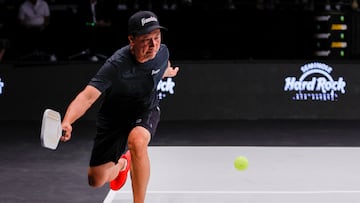What are the differences and similarities between pickleball and tennis?
Pickleball is arguably the fastest growing racket sport in the USA, but how much is different, and in what form from the original - tennis?


Before we start talking about the pickleball/tennis differences, it is worth mentioning the distinction between Padel and Pickleball. Two very similar sports at first look, and despite their similar appearances, pickleball, and padel are two separate sports that have evolved from different origins. Pickleball derived from badminton, whereas padel has its roots in tennis. As a result, the two sports have consequential differences in court dimensions, racquet design, scoring systems, and rules of play.
Pickleball origins
The rapid growth of pickleball in America is no accident. This sport offers a mild activity with a low impact on the body, and its simple learning curve makes it accessible to people of all ages. Unlike other racket sports like tennis, racquetball, or badminton, which may require extensive practice or lessons to grasp the basics, pickleball can be picked up quickly and enjoyed by beginners in no time. This ease of entry is one of the reasons why pickleball has become a popular choice for many recreational players and is driving its surge in popularity across the country.
See also:
- Djokovic breaks racket, “not in the mood to speak”
- The next ‘Big Three’
- Djokovic set for US Open return
According to the U.S. Pickleball Association, Joel Pritchard’s (the inventor of the game, an American businessman and politician who served in the U.S. House of Representatives) wife, Joan, coined the term “pickleball” for their new game. She drew inspiration from the pickle boat in rowing, where oarsmen were selected from the remaining or “leftover” crews. However, Barney McCallum, another co-inventor of the game, had a different story. He claimed that the game was named after Joel Pritchard’s dog.
Pickleball is an affordable and accessible sport that only requires basic equipment and can be played on a small court, making it ideal for entire communities to participate. Even if a dedicated pickleball court is unavailable, many recreation departments repurpose tennis courts to accommodate pickleball. The simplicity and adaptability of pickleball make it a widely accessible sport for people of all ages and backgrounds to enjoy.
Differences with tennis
Court Size
Pickleball and tennis share similarities in that they are both played on rectangular courts with a net dividing the playing area and identical markings on the ground. Additionally, both sports can be played either indoors or outdoors. However, the key distinction lies in the court size, which in pickleball is 20′ x 44′ and is about the same size as a Badminton court.
Pickleball is played on a smaller court than tennis, making it unique and setting its own rules and strategies for players to master.
Playing ball
The ball used in pickleball is typically made of perforated plastic. Officially recognized USAPA (U.S. Pickleball Association) Pickleball balls must have a diameter between 2 7/8 to 3 inches and a weight ranging from 0.8 to 1.02 ounces. Compared to tennis, the Tennis ball is heavier but smaller than a Pickleball ball.
In terms of color, the ball can be any single shade, as agreed by the tournament organizer. These standardized specifications ensure consistency and fairness in gameplay across different Pickleball courts and competitions.
Racquet
While Pickleball and Tennis are racket sports, there are notable differences in the equipment used. Pickleball paddles, for instance, are smaller in size than Tennis racquets, often referred to as paddles rather than racquets. Pickleball paddles are larger than Table Tennis paddles but have a solid surface, in contrast to the woven stringed surface of Tennis racquets.
Furthermore, Pickleball paddles are typically constructed from modern composite materials with advanced performance. On the other hand, Tennis racquets have evolved from wooden handles to graphite and fiberglass compositions, with synthetic or natural gut strings for the woven surface. These material differences in the paddles and racquets contribute to each sport’s unique gameplay and dynamics.
Net
In pickleball, the net is set at a lower height of 34 inches in the middle and 36 inches at the ends from the ground. In contrast, Tennis nets must be 3 feet tall from the bottom. This disparity in net height is another distinctive feature that sets pickleball apart from tennis and affects the style of play in each sport. The lower net height in pickleball adds to the unique dynamics of the game.
Serves
In tennis, the server is allowed two attempts to hit the serve overhanded into the correct service box, making the serve a powerful weapon. Nonetheless, in pickleball, the serve must be executed underhanded, and the server is only granted one chance to get the ball into the correct service box. As a result, the serve in pickleball is not typically as dominant of a weapon as it is in tennis due to the underhanded technique and limited attempts.
Scoring
Scoring in both tennis and pickleball can be perplexing, especially for newcomers.
In tennis, the scoring system involves points such as 15/30/40/Deuce, and Ad-In or Ad-Out. On the other hand, pickleball utilizes a three-number scoring system, adding to its unique complexity. Additionally, tennis employs rally-scoring, where both the serving and receiving team can earn points. In contrast, pickleball restricts scoring to only the serving team.
Related stories
In tennis, faults that result in the opponent scoring include failure to return the ball over the net to the opposing player’s side, allowing the ball to bounce twice on their side of the court, hitting the ball out of bounds, and playing in areas designated for other players (e.g., a singles player entering the doubles court area).
Likewise, in pickleball, the faults that result in the opponent scoring are similar. In addition to the faults above, pickleball also considers volleying the ball during a service return, volleying the ball on the first return immediately after serving, and failing to serve the ball into the correct service box as faults. Furthermore, volleying the ball inside the non-volley zone, also known as the “kitchen,” is considered a fault in pickleball.

